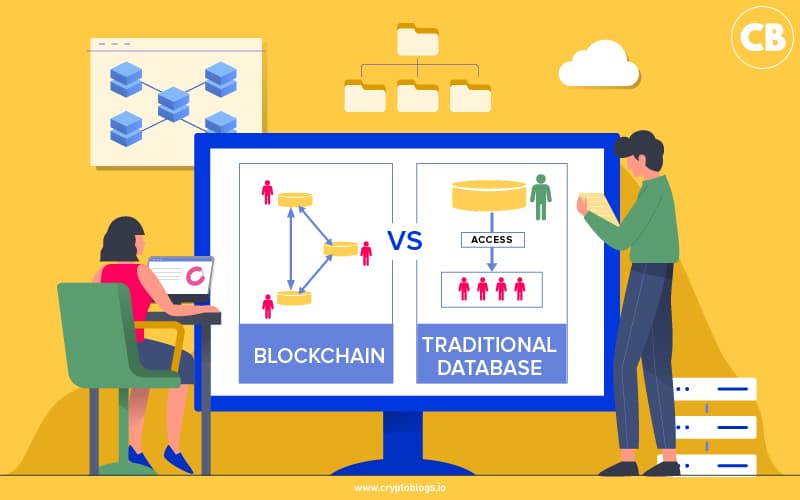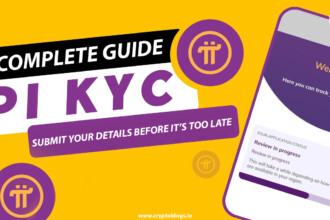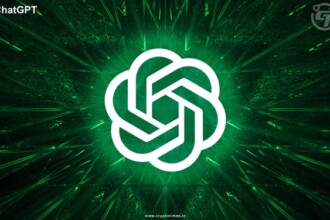Since its inception over a decade ago, blockchain technology has frequently been contrasted against traditional databases. This has sparked many debates about whether blockchain can replace database technology or if the two serve fundamentally different purposes.
At the core of any system today is data – how it is stored, updated, managed, and accessed. Both blockchains and databases have their mechanisms for handling data but take divergent approaches.
This article will analyze the building blocks of blockchain and database systems to highlight their similarities and differences. We dive into the technical architecture that enables network participation, security, speed, and scalability.
We also assess suitable use cases for each technology based on their inherent technical trade-offs.
What is Blockchain Technology?
Blockchain is a novel database structure that enables decentralized record-keeping and transaction processing.
Rather than relying on a central server like traditional databases, a blockchain database is distributed across a peer-to-peer network of computers that collectively adhere to specific protocols for verifying and recording additions to the database.
Imagine you have a small-scale artisan selling handmade jewelry online and you typically, struggle with chargebacks and fraudulent purchases that cause financial strain.
Blockchain allows buyers and sellers to connect through a decentralized peer-to-peer network rather than route payments through banks and credit card companies. So, when a customer orders a pair of your custom-designed earrings, the platform initiates a smart contract.
This automates payment withdrawal from the customer’s wallet once you mark the order as fulfilled. The transaction adds to a “block” of other verified purchases which gets mathematically validated through the decentralized network.
Architecture of Blockchain
In the blockchain crowd, all the workers (computers called nodes) have an exact copy of the task records (ledgers with transactions).
They use fancy math and voting to verify each person’s work before updating the group’s records copy-by-copy in a chain formation that links it all together securely. This lets them maintain records reliably as a team without any supervisor!
Use Cases of Blockchain
Blockchain use cases benefit from decentralization, transparency, and immutability. These traits disrupt industries requiring multi-party coordination, provenance tracking, or removing middlemen. Some major blockchain use cases include:
- Cryptocurrencies – Allow fast, borderless peer-to-peer transfer of value without banking intermediaries
- Supply chain tracking – Enhance provenance and accountability across global production workflows
- Healthcare records – Securely share patient data across providers while maintaining control and privacy
- Voting – Transparent ballot casting and tallying to strengthen election integrity
- Real estate – Tokenize property as shares for fractional ownership and investment
Also Read: Breaking Down the Complexity: A Comprehensive Guide to Modular Blockchains
What is a Database?
A database is an organized data collection stored electronically on a computer system. It allows storing, modifying, and extracting information for applications, analysis, and more.
Databases typically organize data into tables, fields, and records like a spreadsheet. But they also utilize database management systems (DBMS) that govern database creation, maintenance, and use.
For example, Sarah is a software developer at an online bookstore called TomeTopia. Thousands of users visit the site daily to purchase books, audiobooks, and ebooks from the TomeTopia catalog. Sarah develops a new feature for users to track their reading progress across formats.
Her first step is planning a database to store and organize all the necessary data, including user profiles, book details, and progress indicators. Sarah configures a relational database with three core tables – Users, Books, and Progress. The Users table stores customer data like name, email, address, etc. The Book table catalogs details like title, author, genre, length, etc. for every item sold. Finally, the Progress table links user and book IDs with bookmark locations and completion status.
Data populates across these three tables as users create accounts and begin purchasing content. Complex database queries can retrieve profile information alongside reading milestones.
Architecture of Database
Meanwhile, databases still need someone in charge like a boss (server) telling other computers (clients) what data they can access. Clients faithfully submit queries and live edits to the boss rather than directly fiddling with documentation themselves.
The boss handles all reading/writing of documents stored privately in his locked office (central server) instead of publicly like blockchain.
Use cases of Database
Meanwhile, databases shine for applications centered around complex query processing, data analytics, and rapid read/write speeds:
- Retail and e-commerce – Require high throughput transaction processing to handle purchase orders
- Banking – Process high volumes of credit card payments, equity trades, interest calculations
- Media streaming – Store and serve millions of songs/videos on demand to customers
- Social networks – Analyze relationships in massive user-generated datasets
- Gaming – Simulation of large open worlds pulling data from databases
The constraints around blockchain scalability and latency make it unsuitable currently for data-heavy applications with extensive querying needs.
Databases will continue prevailing for enterprise scenarios while blockchain adoption spreads across the consortium and public settings, starting with the most transformation-ready sectors.
Differences between Blockchain and Database Security
| Blockchain Security | Database Security |
| No single entity controls the network. Instead, consensus protocols involving cryptography, proof of work/stake, incentives, etc. enable nodes to collectively verify transactions and add tamper-proof blocks to the chained ledger. | Databases utilize perimeter security protections like firewalls, access controls, and permissions to protect the centralized data store. Database administrators take charge of granting access levels and protecting against external attacks. |
| Blockchain is designed to be transparent, with all transactions and data being visible to all participants in the network. | Database typically has varying levels of control and data privacy measures in place, with data visibility and access rights managed by the database administrator or the organization responsible for the data. |
While both blockchain and database security aim to protect data integrity and prevent unauthorized access or tampering, they achieve these goals through different architectures, trust models, and security mechanisms.
Conclusion
Fundamentally, blockchains and databases persist in critical information but take divergent architectural approaches. Blockchains operate decentralized peer-to-peer networks governed by participants using cryptography and consensus to validate additions to a shared immutable ledger.
This prevents centralized failures but sacrifices speed and scalability compared to databases. Databases enable efficient complex data operations and analytics under a centralized server but introduce risk as a single point of attack.
These inherent tradeoffs make each technology suitable for different use cases – blockchains for transforming multiparty ecosystems like supply chains and databases for high-speed transactions like banking.
However, as blockchain evolves to overcome limitations and databases adopt distribution aspects, the two models will likely converge across a hybrid spectrum rather than remain strictly dichotomous. While blockchain first targeted deficiencies in financial transactions, ubiquitous data management requires a mixture of accuracy, speed, transparency, and security that no one-size model can achieve alone. As information underpins socioeconomic exchange, blended blockchain, and database architectures will emerge to serve core needs.







